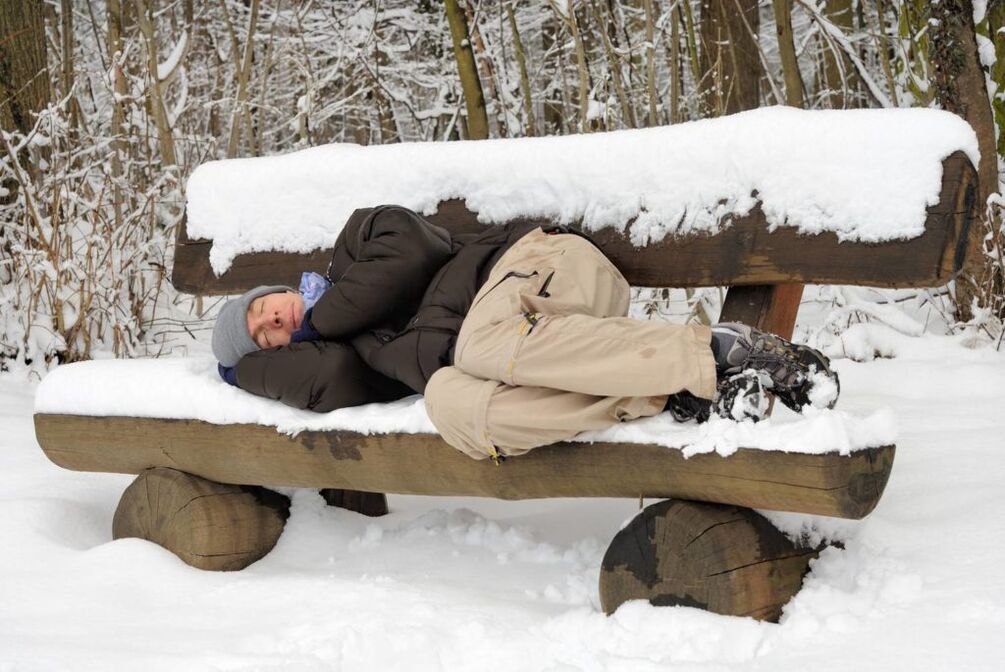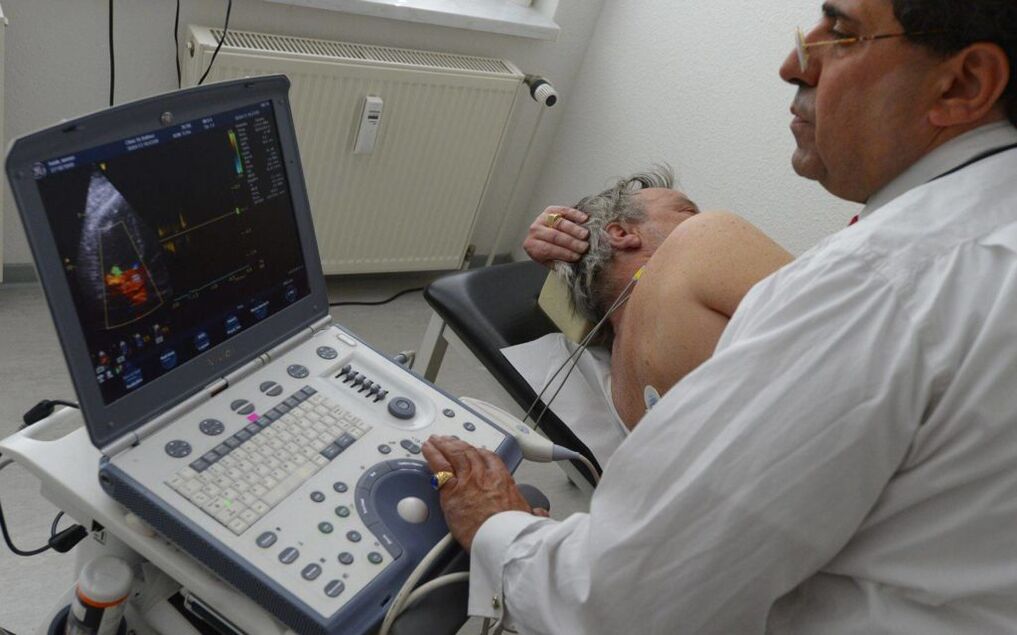Prostatitis is a dangerous disease, but unfortunately, is a very common disease of the male genitourinary system. Previously, the disease mainly occurred in older men, today urologists increasingly diagnose this disease in younger patients. Every man who is concerned about his health needs to know what types of prostatitis are and how they manifest.
Reasons for developing prostatitis

Severe hypothermia of the prostate is the most "sure" way to cure prostatitis.
Prostatitis is an inflammation of the prostate gland. This disease must be diagnosed and treated promptly, otherwise it can have serious consequences.
The causes of this disease are divided into two large groups - infectious and non-infectious. Infectious causes of this disease include:
- opportunistic pathogens always exist in the human body;
- mushrooms;
- sexually transmitted bacteria;
- virus;
- mycobacteria.
The opportunistic pathogens of this disease are Escherichia coli and Pseudomonas aeruginosa, as infectious prostatitis is often caused by these pathogens. They enter the prostate gland from the gastrointestinal tract with the passage of blood or lymph. In addition, the disease can be caused by the invasion of pyogenic bacteria (pneumococcus, staphylococcus) from the urethra or through the bloodstream.
The fungus that causes prostatitis is usually a yeast of the genus Candida. This fungal infection can occur sexually, but Candida is an important part of the normal human microbiome, so it can enter the prostate from other organs and systems. In rare cases, prostatitis is caused by a fungus.
Prostatitis can be caused by infection with syphilis, gonorrhea, chlamydia, and other infections that are transmitted through unprotected intercourse.
In rare cases, viruses become the cause of illness. Therefore, prostatitis can develop against the background of influenza or SARS, in which case the virus spreads throughout the body through the bloodstream. Prostate tuberculosis was isolated separately. This is a dangerous disease associated with internal infection with Koch's bacillus, the causative agent of tuberculosis.
Noninfectious causes of prostatitis:
- stagnation of prostate secretion;
- violation of blood circulation and outflow of lymph from the pelvic organs;
- hypothermia of the genitals;
- Varicose veins.
In general, non-infectious prostatitis is often referred to as the "office worker's disease", because its development is directly related to inactivity.
Risk factors

If in the past the main risk group for this disease was men over 50 years old, today there are more risk factors, so 23-25 year old men are increasingly facing prostatitis. The risk of developing prostatitis is increased by:
- lack of regular sex life;
- sedentary work and low motivation;
- endocrine disorders;
- Hormonal disorder;
- Hypothermia;
- stress;
- Malnutrition;
- bad habits;
- unprotected intercourse.
A poor sex life is the main enemy of the prostate gland. But at the same time, too much sex life also harms this organ. If abstinence is prolonged, it can cause inflammation due to stagnation of prostate secretions, secretions during ejaculation, a rich sex life that depletes the prostate gland, thereby also stimulating the development of prostatitis. paralysis.
The male body needs regular physical activity. Otherwise, the blood circulation of the pelvic organs is impaired, which leads to swelling of the prostate gland and disruption of the vegetative process of the tissues of the organ, and this is the main cause of the development of prostate cancer. non-infectious inflammation. Prostate.
Among the risk factors are impaired immunity, promiscuity and various diseases of the genitourinary system, which can be a potential source of infection.
Classification of prostatitis
To understand what prostatitis is, the classification of the disease will help at the outset. However, it is not advisable to self-diagnose by describing the symptoms. At the first sign of instability, you should consult a urologist. It should be understood that the types of prostatitis manifest in different ways but all threaten men's health if not treated promptly.
Regardless of the form of prostatitis, treatment should begin as soon as possible. Early diagnosis and prompt treatment are the chances of a cure in a few weeks without the risk of complications.
Prostatitis is classified according to the inflammatory nature and the degree of involvement of prostate tissues in the pathological process. Each form of the disease has its own characteristic symptoms that are detected on examination. Therefore, the results of analysis of prostate secretions should be examined in all men suspected of having prostatitis that will most fully describe the type of disease.
What is acute prostatitis?

Before considering specific forms of inflammatory processes in the prostate, it is necessary to understand what prostatitis is by the nature of the course. There are two main forms - acute and chronic inflammation.
Acute prostatitis is a rapidly spreading inflammation of the prostate gland. Usually it is a disease caused by any pathogen. However, the non-infectious form of the disease can also occur in an acute form, for example, during the initial period of manifestation.
Acute prostatitis is characterized by vivid symptoms. Men complain of severe urinary incontinence, severe pain radiating to the perineum, lower back, and anus. Discomfort increases when trying to urinate and ejaculate.
Features of chronic prostatitis
The chronic form of the disease is the result of acute prostatitis. This type of prostatitis in men has less obvious symptoms and is mainly related to untreated or inadequate treatment of acute prostatitis. Pathology is characterized by slow inflammation, which can sometimes be more severe.
Symptoms of the disease: weak urine stream, slow erection, weak excitement. In chronic prostatitis, the urge to go to the bathroom at night is increased, when defecating, there is discomfort in the prostate, manifested by a feeling of squeezing or rupture of the organ.
With hypothermia or decreased immunity, symptoms increase, pain and bladder spasms appear, and the need to go to the bathroom becomes more frequent.
Bacterial prostatitis: features and symptoms
One of the most common types of disease is bacterial prostatitis. It is caused by the entry of many different types of bacteria into the prostate gland. Usually, the causative agent is Escherichia or Pseudomonas aeruginosa, or other opportunistic bacteria that reside in the human body.
The main reasons for its development are weakened immunity, severe stress, smoking and other conditions that weaken the body.
Bacterial prostatitis is manifested by the following symptoms:
- pain and pain when urinating, associated with irritation of the urethra from bacteria entering from the prostate gland;
- high body temperature;
- general symptoms of intoxication: nausea, dizziness, weakness;
- pain in the perineum;
- excretion of blood in the urine.
This form of the disease progresses rapidly and can lead to a prostate abscess. When the first symptoms appear, you should immediately make an appointment with a specialist.
Infectious prostatitis
An infection called prostatitis is caused by bacteria, fungi, and viruses. In fact, bacterial prostatitis is a contagious infection. This type of disease has symptoms similar to a bacterial infection.
The infectious form of the disease can occur in acute and chronic forms. As a rule, the chronic form of the disease develops as a result of complications or improper treatment of an acute inflammatory process.
Viral prostatitis

Acute respiratory viral infection may be a catalyst for the development of viral prostatitis
The most dangerous and least studied form of infectious prostatitis is the inflammatory form of a viral nature. It can be triggered by herpes, the human papillomavirus, the causative agent of measles, rubella, and influenza. Most often, inflammation of the prostate gland occurs on the basis of the spread of the common causative agent of SARS.
The problem with viral prostatitis is that antibiotic therapy is ineffective, and antiviral agents do not penetrate well into the tissues of the prostate gland.
Therefore, a long course of antiviral and immunomodulatory drugs is required, after which the disease is likely to become chronic and continue with other drugs. This form of prostatitis often leads to infertility at a young age.
Fungal prostatitis
This is a rare disease caused by a fungus of the genus Candida. The main feature of this type of inflammation is that there are almost no symptoms in the early stages. Thus, fungal prostatitis does not manifest in an acute form, but immediately turns into a chronic disease.
Purulent prostatitis
This is the most serious and dangerous form of infection caused by pyogenic bacteria. The pathology progresses in an acute form, manifested by high body temperature and the release of purulent masses from the urethra. The disease can lead to an abscess of the prostate, requiring urgent hospitalization and surgical intervention, otherwise the abscess can rupture and become infected with pus draining outside.
Computational form of inflammation
Stones or stones can form in the prostate gland. They are deposits of phosphates and calcifications in the wall of the organ. Calculi stimulates prostate tissue, causing an inflammatory response. This form of disease is characterized by blood in the urine and painful defecation due to the movement of salt deposits due to muscle tension and damage to prostate tissue. This form of the disease is common in older men. Alternatively, prostatitis can be considered a complication of congestive prostatitis that the man has not treated.
Diagnose

After understanding the types of prostatitis in men and the symptoms of the different types of inflammation, it becomes clear that the diagnosis should be made individually by a specialist. It is necessary to contact a urologist at the first sign of instability and undergo examinations. To make a diagnosis, the prostate gland is palpated, prostate secretions analyzed, and an ultrasound of the organ is performed.
The cause of inflammation is determined by the composition of the prostate juice, its consistency and quantity. Ultrasound is done to rule out prostatitis. Based on the results of these tests, a diagnosis is made and an optimal treatment regimen is devised.
Treatment of inflammation
The signs and symptoms of prostatitis depend on the type of disease. Treatment is selected individually for each patient, depending on the nature of the inflammatory process. In general, all bacterial inflammatory processes are treated with broad-spectrum antibiotics with antibacterial activity. To treat diseases caused by viruses, antiviral drugs and drugs to strengthen immune defenses are used. The fungal form of the disease requires the use of special drugs - anticonvulsants.
To eliminate non-infectious inflammation, so-called prostatic biostimulants are used. These are drugs that improve the properties of the tissues of the inflamed organ, dilute the secretions of the prostate gland and stimulate its secretion. These drugs improve the functions of the body.
In addition, symptomatic treatment is prescribed. In the acute form of the disease, non-steroidal anti-inflammatory drugs are used to relieve pain and reduce fever. If a man has severe problems with urination, medicine is used to relax the muscles of the bladder and urethra - alpha blockers.
In addition, herbal diuretics, suppositories that improve blood circulation in the gland, anti-inflammatory drugs with a natural composition and other groups of drugs are used.
It is important to remember that self-medication can be very harmful to health. Drug therapy should be prescribed only by the attending physician.
How to prevent the development of the disease?

To prevent disease, you should go for regular health check-ups.
Prostatitis prevention is a topical issue for every man. To have a healthy prostate, you must:
- treat all diseases in a timely manner;
- always dress appropriately for the weather and avoid hypothermia of the genitals;
- take care of your health and use birth control methods;
- live an active lifestyle;
- exercise and sports;
- refuse bad habits;
- Eat right.
As a precaution, all men are advised to consume pumpkin seeds in small amounts, as this product is a natural prostatist.
In addition, all men over the age of 40 should see a urologist every year, even if there are no complaints.
































